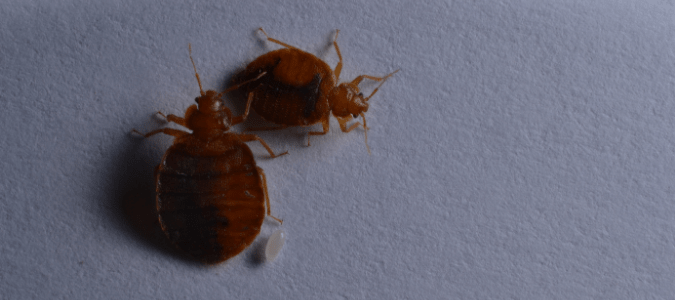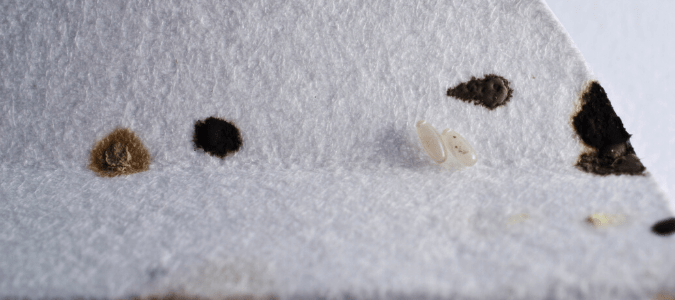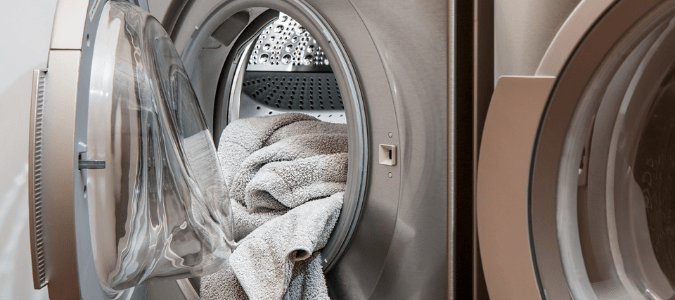Do you know the typical signs of bed bugs and how to determine them from other types of household pests? The best way to catch a bed bug infestation before it goes too far is to understand the appearance of bed bugs in all parts of their life cycle.
In this article, you will learn what bed bugs look like, what color they are and how their appearance changes before and after a blood meal. You will also discover what bed bug stains look like, as well as other common signs of bed bugs. Equipped with this information, homeowners can catch an infestation even before they spot bed bugs in their home.
A bed bug infestation does not mean that your home is dirty, but it is crucial to treat the problem as soon as possible. This article will highlight how to get rid of these pests.
The Color of Bed Bugs Throughout Their Life Cycle
Young bed bugs, which are often referred to as nymphs, are hard to see because they are tiny and translucent in color. If they have eaten recently, they will turn a white or yellowish color that makes them easier to spot. However, if they have not eaten in a while, they are almost invisible.
As bed bugs grow, their bodies elongate. Then they turn a brown color that is easier to see. Adult bed bugs have an oval body that is around the size of an apple seed. They do not get bigger than five millimeters.
Bed bug eggs require a magnifying glass to see. They are a pearly white color and about the size of a pinhead. They are almost impossible to see; however, one thing that helps is that after five days old they have a dark mark on their eye spot.
Bed Bugs Before and After a Blood Meal
Bed bugs feed on blood to survive, and they often do it when you are sleeping and do not notice it. Female bed bugs must eat to be able to produce eggs, but in general, bed bugs can survive for a long time without a meal. However, it is still helpful to know the difference in how bed bugs look before and after they’ve had a blood meal.
Nymphs must have a blood meal before they molt and grow to their next stage. There are five nymph stages before they become adult bed bugs. Every time they eat, nymphs turn a yellowish color that makes them easier to see.
Adult bed bugs only change slightly in color from brown to red when they eat. However, their oval-shaped bodies become longer and balloon up in size.
What Are Bed Bug Stains?
One way to identify a bed bug infestation is to look for bed bug stains. Since bed bugs usually feed on humans while they sleep, they hide all around your bed. A pest control professional will likely identify them in your mattress, box spring and bed frame.
When you change your sheets, inspect your mattress and bedding for brown or rusty red-colored stains. These stains are left when the bodies of bed bugs are crushed in your bed. Along with inspecting your own bed, you should also inspect the beds of hotels when you are out of town.
Another type of stain can occur from bed bug droppings. This stain is smaller and darker in color and looks like a marker bleed. Lastly, bed bug nymphs shed their pearly-colored egg shells and skins as they molt, and you may see those left behind on your mattress.
If a bed bug infestation is advanced, the bed bugs may also make their way to other furniture in your home. If you spot bed bug stains on your mattress, you should also inspect the other upholstered furniture in your home for stains, like your couches, chairs and ottomans.
If you see stains, call a pest control expert right away. While there are some actions you can take yourself to deal with the infestation, they are most effective when paired with professional treatments.
Common Signs of Bed Bugs
Besides bed bug stains, there are other ways to spot an infestation. You may notice bed bug bites and rashes on your skin when you have an infestation. However, they are hard to distinguish from other types of bug bites, and some people do not react to bed bug bites at all. If you don’t have a reaction, that does not mean that you don’t have a bed bug infestation.
Adult bed bugs give off an unpleasant musty odor. Unlike termites, bed bugs do not chew through wood. However, they do like to hide in wood crevices. Along with your bed frame, you should also inspect your baseboards and behind picture frames on the walls.
Other creative bed bug hiding spots include electrical outlets, around the edges of your carpet and inside books. You can also carry bed bugs into your home in your luggage and on second-hand clothing.
It’s important to eliminate these pests from all of their hiding spots so that the infestation does not come back. A bed bug exterminator will be able to inspect all potential hiding places that you may not know about.
How to Clean For Bed Bugs
There are several steps that homeowners can take to help get rid of bed bugs. However, it’s important to note that infestations are extremely hard to totally eradicate without professional help.
You must be patient and proactive to fully rid your home of bed bugs, as they can live for months without a meal. Female bed bugs lay up to five eggs per day. The suggestions below should be used in addition to hiring a pest control expert to treat your infected areas.
Cleaning the Affected Areas
As soon as you see a bed bug or bed bug stain, clean the affected areas. Wash your bedding and clothing with hot water and dry in hot heat to kill off the bugs. If you have items that can’t be washed, like shoes and stuffed animals, put them in the dryer on hot heat for at least half an hour.
If you have infested items that cannot go in the washer or dryer, seal them up in a plastic bag for a week to suffocate the bed bugs. Give the items a thorough inspection to make sure that all the bed bugs are dead before you introduce them back into your home.
Next, brush your mattress with a stiff cleaning brush to scrub away bed bugs and their eggs. Then, vacuum all over your mattress and the area around your bed. Use a flashlight to identify hard-to-see areas where the bed bugs might be hiding.
Go over all of the infested areas with the vacuum multiple times, and then immediately discard the vacuum bag in an outdoor trash can. When you are done, clean your vacuum thoroughly.
Remove Their Hiding Places
Bed bugs are hardy and resilient, and they can live for several months without a blood meal. Even after all of these cleaning methods, you could still have a bed bug infestation. It’s wise to wrap your mattress in an airtight zippered covering for at least a year to suffocate any remaining bed bugs.
Clothes, books and other items cluttered around your bed can also become clever bed bug hiding places. Make sure you thoroughly wash and clean all of these items and keep them away from your bed in the future. Put all of your dirty clothes into a laundry hamper instead of letting them pile up by your bed.
While you are cleaning, do not take items from the bed bug-infested room into any other area of your home except for the laundry room to prevent the infestation from spreading further. Finally, look for cracks in your plaster, rips in your wallpaper and other holes where bed bugs can hide. Repair the damaged areas to make it harder for them to survive and return.
If an infestation has gone too far, some furniture and personal items may need to be thrown out if they cannot be saved after deep cleaning. Consult a professional to determine the extent of your pest infestation.
The first step to getting rid of bed bugs is to understand the signs of an infestation. While bed bug eggs and nymphs are hard to see with an untrained eye, adult bed bugs are easier to spot. Look for their brown or red bodies around your bed, furniture, baseboards and other clever areas where they hide.
ABC Can Get Your Bed Bug Problem Under Control
Bed bug problems can take a large toll on you and your family. When you notice an infestation, contact ABC Home & Commercial Services. We have multiple strategies at our disposal to control bed bugs, so you and your family can be comfortable again.



